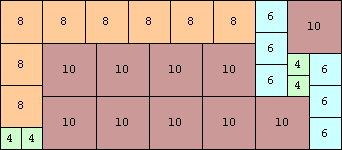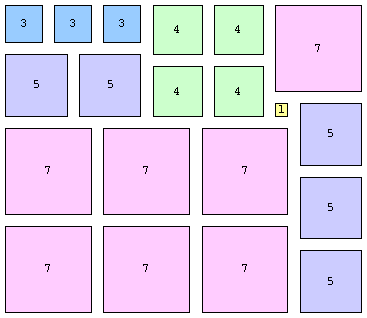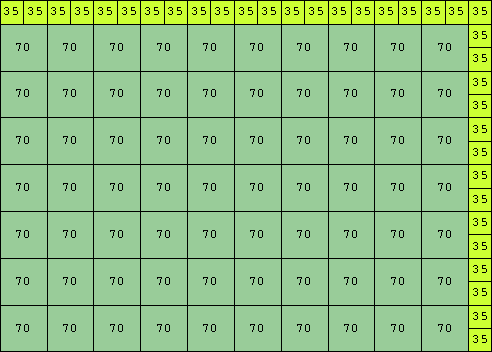

We can also look for Border Sub-Partridge Tilings, a tiling of a rectangle with squares with a border of width 1 around each square. For example, a {1,3,4,5,7} border tiling is shown below. What border sub-partridge tilings exist?


The second is {2,4,6,...2n}, as shown by the following tiling:

The third is {4,8,24,60,...4FnFn+1} (where Fn is the nth Fibonacci number), as shown by the following tiling:

Jeremy Galvagni showed that {a2bc,ab2c} tilings exist. He conjectured that these are the only sub-partridge tilings using only two sizes of squares.
Luke Pebody showed that this conjecture isn't true by finding the {35,70} tiling below. He and Emilio Schiavi showed that an {n,2n} tiling does not exist precisely when n is an odd prime or n=1, 9, 15, 21, 25, 27, or 33.

Patrick Hamlyn found many sub-partridge tilings with his tiling program.
Patrick Hamlyn and Jeremy Galvagni noted that border tilings are equivalent to tiling n-1 copies of each square of side n without borders.
Claudio Baiocchi notes that if there is a {a1, a2, . . . an} tiling, then there is a {k a1, k a2, . . . k an} tiling for every k, and that for every {a1, a2, . . . an}, there exists some k so that there is a {k a1, k a2, . . . k an} tiling.
| Largest Square | Number of Sizes | Tilings |
|---|---|---|
| 5 | 2 | {2,5} |
| 7 | 5 | {1,3,4,5,7} |
| 6 | {2,3,4,5,6,7} | |
| 8 | 7 | {2,3,4,5,6,7,8} |
| 8 | {1,2,3,4,5,6,7,8} | |
| 9 | 2 | {4,9}, {5,9} |
| 3 | {5,8,9} | |
| 6 | {3,4,5,6,8,9} | |
| 7 | {1,2,4,6,7,8,9} | |
| 8 | {1,2,3,4,5,7,8,9}, {1,2,4,5,6,7,8,9} | |
| 9 | {1,2,3,4,5,6,7,8,9} | |
| 10 | 8 | {1,2,3,5,6,7,9,10} |
| 11 | 2 | {3,11} |
| 4 | {2,5,8,11} | |
| 7 | {1,3,4,5,7,9,11} | |
| 8 | {1,2,3,4,5,6,9,11} | |
| 13 | 2 | {6,13} |
| 14 | 2 | {5,14}, {9,14} |
| 3 | {5,9,14} | |
| 4 | {2,8,11,14} | |
| 15 | 4 | {5,8,9,15} |
| 16 | 3 | {3,11,16} |
| 17 | 2 | {8,17} |
| 4 | {5,8,9,17}, {8,9,14,17} | |
| 18 | 3 | {8,17,18} |
| 19 | 2 | {4,19} |
| 3 | {4,9,19} |
If you can extend any of these results, please e-mail me. Click here to go back to Math Magic. Last updated 1/31/06.